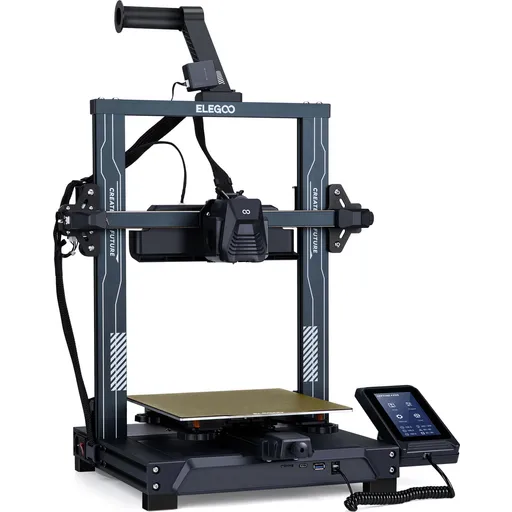Compare Neptune 4 PRO vs Ender 3
Comparison between the best 3D printers
Choose the best 3D printer at the best price. The cheapest 3D printers are here.
Buy a 3D printer here with 3D Fila.
 |
 |
|
| Model | Neptune 4 PRO |
Ender 3[BUY Ender 3] |
| Printing Material | Filament | Filament |
| Buy Filament for Elegoo Neptune 4 PRO | Buy Filament forCreality 3D Ender 3 | |
| Estimated price | $359,00 | $210,00 |
| Manufacturer | Elegoo | Creality 3D |
| Release Year | 2023 | 2018 |
| Print Volume [mm] | 225x225x265 | 220x220x250 |
| Printer Size [mm] | 475x445x515 | 440x440x465 |
| Weight [kg] | 8,9 | 6,62 |
| Power Loss Recovery | YES | NO |
| Enclosed printer | NO | NO |
| Bed Leveling | Automatic | Manual |
| Filament End Sensor | YES | NO |
| Bed type | Heated | Heated |
| Power supply system | Direct Drive | Bowden |
| Standard nozzle | 0,4 | 0,4 |
| Maximum Nozzle Temperature [°C] | 300 | 255 |
| Maximum Bed Temperature [°C] | 110 | 110 |
| Maximum printing speed [mm/s] | 500 | 180 |
| Filament holder | YES | YES |
| Camera for supervision | NO | NO |
| Recommended filaments | PLA, PLA+, TPU, PETG, Nylon, ABS | PLA, TPU, ABS, PETG |
| Recommended slicers | Bambu Studio, Super Slicer, Cura, Prusa Slicer, Orca | Cura, Simplify, Slic3r |
| Maximum Resolution [mm] | 0,1 | 0,1 |
| Processor | ARM 64 bit | 8 bits |
| Display | Touchscreen 4,3'' | Mono |
| Power Supply | 310 W | 24V / 270W |
| Connectivity | USB, microSD | SD / USB |
| Operating systems | Windows, Linux, Macbook | Windows, Mac, Linux |
| Date of registration in the system | 2024-07-02 | 2021-04-13 |
| Release date | 2023 | 2018 |
| Extra features | The Elegoo Neptune 4 Pro stands out for its advanced features, including pre-installed Klipper firmware, a dual-gear direct extruder with a 5.2:1 ratio, a high-temperature nozzle (up to 300°C), a flexible magnetic PEI platform, efficient cooling fans, and a 121-point auto-leveling system. The printer also features a 4.3-inch touchscreen interface, dual linear bars on the X and Y axes, and a segmented heated bed for energy savings. | The Ender 3 V1 is a DIY assembly 3D printer, a sales leader since 2017, standing out for its cost-benefit. With a wide printing capacity, it has a CNC machined structure for precision and stability. It offers high-precision prints with low noise, thanks to its innovative V-profile and pulleys. It has a self-adhesive magnetic platform for easy removal of models and excellent adhesion. The Ender 3 heats up quickly, reaching 100°C in 5 minutes, ideal for agile prints. It includes protection against power failures, allowing you to resume printing after interruptions, saving time and material. |
| Support for multiple colors and materials (AMS and CFS) | NO | NO |
Notes * |
||
| Cost-benefit | 7 / 10 | 6 / 10 |
| Hardware | 3.2 / 10 | 0.5 / 10 |
| Tela | . | . |
| Print volume | 3 / 10 | 3 / 10 |
| Performance | 4 / 10 | 1 / 10 |
| [BUY Ender 3] |
Conclusion |
| In comparing the Elegoo Neptune 4 Pro and the Creality Ender 3, several key factors influence the decision for potential buyers. The Neptune 4 Pro, being the more recent release, offers advanced features such as automatic bed leveling, a higher maximum nozzle temperature, a direct drive extruder system, and a larger print volume. Its ease of use is further enhanced by a touchscreen interface and a robust recovery feature for power interruptions, making it more suitable for both beginners and experienced users seeking reliability and efficiency. On the other hand, the Ender 3, despite being an older model, remains a popular choice due to its affordability and solid performance. Its manual bed leveling and Bowden extruder may require a bit more hands-on intervention, making it less accessible for novice users. Nevertheless, its cost-effectiveness and DIY assembly appeal provide an engaging experience for hobbyists and those looking to save money. Thus, if one is willing to invest in a printer that combines advanced capabilities with ease of use, the Elegoo Neptune 4 Pro presents a compelling option. Conversely, for those on a tighter budget or who appreciate the satisfaction of building and fine-tuning their own machine, the Creality Ender 3 offers tremendous value. Ultimately, the decision should reflect individual priorities in features, budget, and printing goals. |

